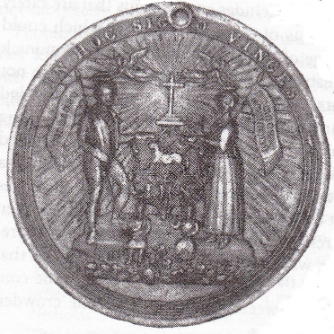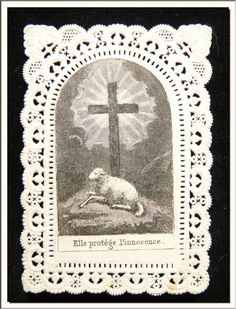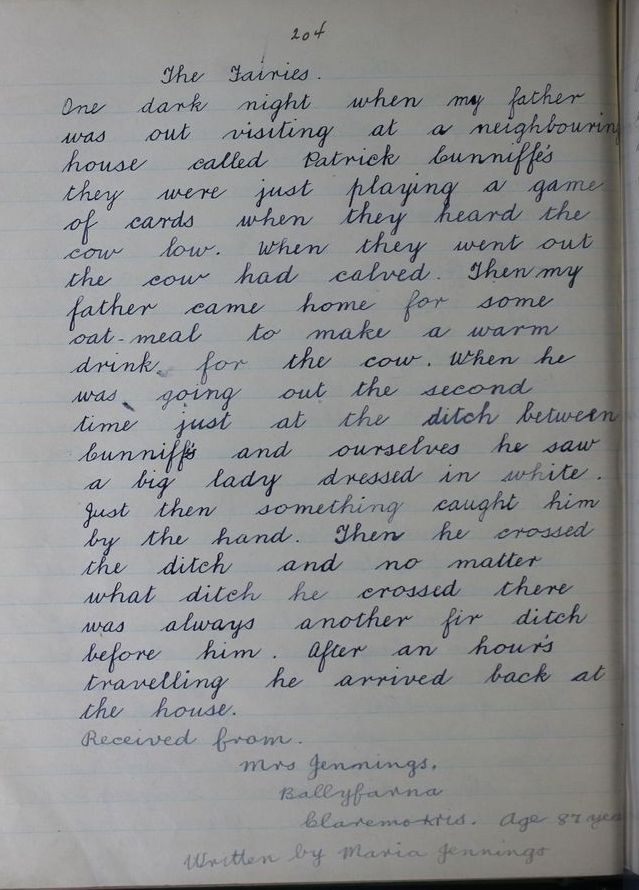Knock witnesses were unduly influenced by
things they had already seen
The trouble with some apparition stories about Jesus' mother, is that they might look convincing, particularly when they are in the past and look convincing simply because we forget that they might have arisen in a superstitious culture that programmed people to be prone to visions. If a hundred stories are cooked up one of them might look good while the others fade away into forgotten memories.
The Knock vision has some similarities to the White Lady legends. The lady is in white and somebody usually is about to die when she appears. Judith Campbell's mother comes to mind. The stories are linked to purity and husbands feature in the visions. A man bowing at Mary at Knock was presumed to be St Joseph.
The White Lady nearly always is silent and looks pale and
is in a white dress. Wedding dresses feature a lot and the Knock vision could be
interpreted as a bride with a crown.
Interestingly, the Malta White Lady appears after 8 pm. So does our Knock lady.
Malta Lady has a shadow that she wants you to get trapped in. A shadow – a dark
mearing – was reported at Knock.
The witte wieven, white maidens, of the Netherlands usually come across and
kindly and prayerful. Fog and mist if it is mere wisps is usually taken to be a
vision of one of those ladies.
The Silk Lady of Louisana wears a white dress and like the Knock lady her feet
do not touch the ground.
Nothing in Knock seems that out of the ordinary when you count the White Lady stories from all over the world.
Lisa Bitel wrote about how believers in visions see visions in things that are plainly not visions. They interpret shapes as being Mary though no sceptic can see how it could pass for Mary. She wrote that a triangular shape of light will be imagined to be the Virgin Mary (Bitel 2009: 85–6).
The Knock vision
When investigating apparition claims, if the visionary
seems to be copying from something else, the vision is regarded as false.
Imitation is regarded as clear evidence that the vision claims are not to be
taken seriously. That is Church policy. But it has not stopped the Church from
following apparitions that do copy other apparitions or accounts that
plagiarise. There must be no copying. If you see an image of Mary that matches a
statue of her that you have in the house, experts will think you are pretending
to see her and are describing the statue when you describe the vision because it
helps you keep your story straight and sound more real.
On the night of the 21st of August 1879 the Virgin Mary flanked by St Joseph
and a bishop thought to be St John the Evangelist and an altar with a lamb and
cross on it allegedly appeared on the gable wall of the Parish Church for a few
hours. Fifteen people witnessed the vision including a child of five (page 60,
The Evidence for Visions of the Virgin Mary) and stood watching it for two hours
allegedly in torrential rain.
The claims were investigated by a commission not long after.
Top witness Mary Beirne stated, " In the figure of St. Joseph the head was
slightly bent, and inclined towards the Blessed Virgin, as if paying her
respect; it represented the saint as somewhat aged, with gray whiskers and
grayish hair. The third figure appeared to be that of St, John the Evangelist ;
I do not know, only thought so, except the fact that at one time I saw a statue
at the chapel of Lekanvey, near Westport, County Mayo, very much resembling the
figure which stood now before me in group with St, Joseph and Our Blessed Lady,
which I beheld on this occasion. He held the Book of Gospels, or the Mass Book,
open in his left hand, white he stood slightly turned on the left side towards
the altar that was over a little from him. [ORIGINAL SAYS, "I NEVER SAW FIGURES
OR STATUES LIKE THEM" - THIS WAS OMITTED AS IT OBVIOUSLY CONTRADICTS HER CLAIM
THAT SHE SAW A STATUE OF JOHN LIKE THE ONE IN THE VISION - READ ON TO SEE WHAT
SHE CLAIMED] I must remark that the statue which I had formerly seen at Lekanvey
chapel had no mitre on its head, while the figure which I now beheld had one —
not a high mitre, but a short-set kind of one. The statue at Lekanvey had a book
in the left hand, and the fingers of the right hand raised. The figure before me
on this present occasion of which I am speaking had a book in the left hand, as
I have stated, and the index finger and the middle finger of the right hand
raised, as if he were speaking, and impressing some point forcibly on an
audience. It was this coincidence of figure and pose that made me surmise, for
it is only an opinion, that the third figure was that of St. John, the beloved
disciple of our Lord. But I am not in any way sure what saint or character the
figure represented, I said, as I now expressed, that it was St. John the
Evangelist, and then all the others present said the same — said what I stated."
Knock witness Catherine Murray also claimed to have seen the Lecanvey statue
and said it resembled the bishop figure.
It is true that there is no evidence that the statue was there but what if
it was? Whatever the truth is, the fact remains is that she is saying the image
of the bishop was seen somewhere before.
The accounts made by the visionaries to the commission describe Mary
standing between two saints one of whom was a bishop wearing a low mitre. The
scene matches the depiction of Mary between a saint and a bishop like that in a
stained glass window in nearby Ballyhaunis (pages 237-240, Knock The Virgin's
Apparition in the Nineteenth Century) too well to be a coincidence. Most of the
visionaries probably saw it and it influenced what they thought they saw at the
gable. Patrick Hill (same source) declared that the images he saw on August 21
resembled holy pictures he had seen. The Ballyhaunis window has Mary dressed in
white standing higher than the other two figures. One figure is bowed to her.
All this was duplicated at Knock. And there was a mitred figure on the other
side of her as well in the Ballyhaunis image. The bishop figure there was St
Augustine. He resembled the John figure at Knock.
The Temperance medal, which would have been familiar to many at Knock, which
showed an altar with angels flying around it and a lamb on it with a cross
behind the lamb is a perfect match for the altar seen at Knock (page 240, Knock
The Virgin's Apparition in the Nineteenth Century). The medal and the vision
depicted the altar as emitting light. Some visionaries denied seeing the cross
and the altar.

All this suggests that the visionaries were not sure what they saw and their
memories got mixed up with other things they had seen.
Suppose God really did engineer the image of the Lamb on the altar with the
cross at Knock. He would be advertising the temperance medal. The temperance
medal carries the words In Hoc Signo Vinces. Jesus supposedly said those words
to Constantine to encourage him in religious war. The medal implicitly
encourages the notion that religious visions have the right to command war!
Dangerous!
It is felt that lamb of God emblems and cards that were given out as gifts at Catholic schools were possibly the inspiration for the lamb on the altar with the cross.

Here is a story from the Duchas collection of tradition and heritage. The
schoolchildren in the Republic of Ireland in the 1930's had to talk to an older
person about tradition and write down what they said as part of a school essay.
This enterprise became the National Schools Folklore Collection. The story
comes from Claremorris which is not far from Knock. It shows how
apparitions that nobody said were Mary were taken to be of fairy women.
The story only guesses that this "big lady dressed in white" is a fairy woman.
If it could be Mary then why not? The Collection is remarkable for how
little interest the Knock visions of 1879 got from locals. No child in
Knock wrote an essay about the visions. That is what you would expect if
the vision story was seen as just another tradition in an area saturated with
magic.

Mrs Jennings was born about 1850 and would have been about 29 or 30 at the time of the Knock vision. It is possible her father reported this experience in the 1870's. Why the vision was not taken to be of Mary is bizarre! If it had not been for a figure like a bishop at Knock the apparition could have been interpreted very differently. Remember the tradition about the cross and the altar been seen is uncertain and many witnesses never mentioned it.
Knock The Virgin's Apparition in Nineteenth Century Ireland shows that the original Knock apparition was reported by people and a society that delved heavily into superstition and often couldn't separate reality from religious fantasy. The apparition then in that context would certainly be an encouragement to such a society. If you honour Mary, don't insult her by claiming that the Knock apparition was really her! If you claim that it was, you are saying she was a catalyst for superstition.
BELIEF IN FAIRIES AND THEIR APPEARANCES AND MIRACLES WAS INTENSE IN THE WITNESSES' CULTURE
From MEMORIES OF KNOCK IN THE EARLY NINETEENTH CENTURY Memoir of
Daniel Campbell, Eden and Smethwick, written c. 1880
Edited and introduced by NOLLAIG Ó MURAÍLE
(Based on a typescript by Fr John Baptist Byrne, CP) 1989 (revised 2006-7)
This record shows the great fear and faith people had then in the Priest's Curse. Is it possible Archdeacon Cavanagh and others were secretly threatening witnesses to the alleged vision at Knock? The Sister of Kenmare referred to at the end of this excerpt is Cusack who did investigate Knock's apparition claims and some of those involved. He seems to hint that there are things he knows that she does not about that subject. She would publicise the real story.
THE FAIRY-WOMAN
Now I must give a little account of Mary Meegh or Mrs Moran, wife of
Anthony Moran of Lower Oughteboy, within half a mile of Balina
Costolo. She
was the fairy-woman of the district and I know different people came
to her from different parts of the country for the purpose of
keeping the fairies away from themselves or their friends, or
perhaps to cure some person overlooked by the evil eye or a
red-haired man or a black-eyed woman, or, as the case might be, to
restore the butter that was stolen from the cow’s milk on May Day by
some evil-disposed person, or it might be the sow did not take to
the litter of bonaveens as she ought to do, or perhaps one of the
hens began to crow or the cock crew at the wrong time, which would
be a sure sign of bad luck, and a stitch in time saves nine. So Mary
Meegh was consulted in time about these things and her salary or fee
was 2/6 or 10/- according to the case. And before she commenced, a
bottle of whiskey was requisite, for she would not undertake any
difficult case unless without a drop of whiskey to help her to
encounter the fairies. This looks like a romance, but I assure the
reader it is the
real unvarnished truth, and many witnesses I could bring forward to
produce [? support] it if required.
25. FAIRY FRAUD
Fr Pat O’Grady being parish priest often cursed her from the altar
of Knock. Still she carried on her old game, but when she had
a child to christen or herself to be churched she would promise
faithfully never again to be guilty of such conduct, but no sooner
was her child christened or herself churched than she began to
follow her former occupation, although she was cursed by the Church
or anyone speaking to her [was cursed]. When going to cure any
person or animal she always fainted and went to consult the king or
queen of the fairies, and through her interfering she often obtained
her request, although the parties were already doomed to Fairyland.
On one occasion a young man went to consult her about his wife. He
told her he thought she was overlooked or an evil eye bewitched her.
So she fainted as usual and told him that his wife was already with
the fairies and she would have great trouble to restore her to him.
But by complying with her directions and paying the usual fee the
wife would be as well as ever in a few days. She told him the
description of the person that bewitched her – but the best of it
all was: he had no wife and never was married! I could write more
about similar cases, but that is sufficient for my purpose. For I
will leave her to her fate, for I believe she is gone to her account
many years ago.
30. THE FAIRIES
I have given a little description of Mary Meegh, or Mary Moran, the
fairy woman. Now I must tell you a little about the fairies
themselves, for Knock
was a favourite place for those good people. For any traveller
passing from Balina Costolo to Knock church can see the residence of
the fairies, or where they kept their nocturnal revels, and the
trespassers on their festivals are doomed unless saved by some
friend that has been taken away by the fairies [who would] intercede
for them. [15] I will give an instance later on of one case that
comes under my personal observation, or at least the party
concerned. I heard it stated to a gentleman who was my father’s
landlord and also landlord to the party concerned.
31. FAIRY FORTS
As the traveller passes through for Knock along the road from Balina
Costolo, on the righthand side of the townland of Shanvahera, there
is a fort – or ‘forth’, as we generally termed it. This has a cave
in it, and I believe it was never explained properly for the reason
that people did not like to intrude on forbidden ground. I think
there are one or two more in the townland of Shanvahera. As the
traveller goes on a little higher, there are two more forths [to]
the left of Edenpark Estate, one to the back of Edenpark House
called Dooneen, from which a beautiful view can be obtained; and it
would pay a visitor to Knock for his trouble, for on a clear day a
distance of 40 or 50 miles can be seen from the top of Duneeneden.
The writer spent many a day in the fields just by on the righthand
side as the traveller passes Cumeeldugh on the road that leads to
Swinford and Kiltimagh and separates Heemeel and Shanvahera.
32. HEEMEEL ‘FORTH’ AND CHILDREN’S BURIAL GROUND
There is a large forth to the righthand over the little village of
Heemeel which was inhabited by the Carnies. There were briars and
berries growing on this forth. On many a Sunday evening young men
and young women often assembled there to have a chat and many to
throw a stone or try their skill at wrestling and many other manly
sports. But all took good care to be off the ground before it grew
dark. I would not say so much about this forth but it was used as a
burying-place for still-born children and children under a certain
age who were supposed to be taken away by the fairies at night. I
remember one or two of our next-door neighbours’ [children] being
buried there who happened to die at night or were smothered by the
mother. It was a good excuse. The fairies took them by night, and
some old woman or some person heard the child crying with air as the
fairies were carrying it away. So there was neither crooning
[=keening], inquest nor certificate of death required, for it was
buried in the forth.
33. OTHER ‘FORTHS’ IN KNOCK
About 300 yards’ distance to the south [stood] another forth of
Heemeel, round [in] shape, but neither bush nor briar grew in the
round forth. It was tilled regularly every year. Then, at a distance
of 400 or 500 yards, as you pass the lighthouse gate, there is
another forth on the Eden Estate, and it was commonly believed that
there [16] was subterranean passages from one to the other. Some
said they [i.e. the forts] were the dwelling places of the Danes
when in Ireland.
The name shows what they were made for – fort or fortification, now
called ‘forth’ by the country people. There are a good many more of
them at Knock, but they [i.e. the fairies] seem to choose Shanvahera,
Eden and Shinoghmeel for their favourite residence. There is another
of these on Cnoc na Breena [Cnoc na Bruíne], or the hill of Breen,
which rises above the chapel, the highest part of the parish (or I
might say of Ireland [!]), excepting Cnoc na Geeghey, or the windy
hill, about a mile distant. The latter is in the parish of Kilcolman.
The river of Ballaghahooly separates the two parishes and, I
believe, the two baronies also, Costolo and Clanmorris.
48. MOLLY MORRIS
There was another person of whom I wish to write. She was a pilgrim
named Molly Morris. She was not a native of Knock but she clung to
it as her home and got a living among them. (In general, they were a
rough lot, though they respected religious people.) Molly Morris was
also allowed the privilege of being admitted to the sacristy; and
always while Fr Pat was having his breakfast she managed to be on
her knees behind his chair reciting the Rosary, for she had beads
that contained the 15 decades. He might eat one or two mouthfuls of
the cake that his housekeeper, Mrs McGreal, sent him and take the
punch prepared by his clerk, Dominic Bourke. He might also have a
sip or two and then, without uttering a word or looking behind him,
he would first hand the cake to Molly and then the punch, which many
of us youngsters grudged her.
49. SUMMING UP
I will say no more in this sketch, but if Mrs Sadler or the Sister
of Kenmare had all the material and knew all I could tell them about
Knock, they could write volumes. I have not given much about the
sayings and doings of the people of Knock: it would read more like a
romance. There are not many families in the parish that I cannot
give a little of their history.





